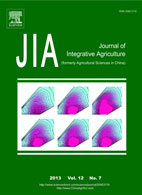|
|
In vitro Ruminal Gas Production Kinetics of Four Fodder Trees Ensiled With or Without Molasses and Urea
Abdelfattah Z M Salem, ZHOU Chuan-she, TAN Zhi-liang, Miguel Mellado, Moises Cipriano Salazar, Mona M M Y Elghopur , Nicholas E Odongo
2013, 12(7):
1234-1242.
DOI: 10.1016/S2095-3119(13)60438-4
This study investigated if the addition of urea (U), molasses (M) or their 1:1 (v/v) mixture during ensiling increases the nutritional value of forage from four fodder trees (Prunus persica, Leucaena esculenta, Acacia farnesiana, and Prunus domestica). Forage samples of fodder trees were collected in triplicate (three individual samples of each species) and subjected to an in vitro gas production (GP) procedure. Fermentation at 24 h (GP24), short-chain volatile fatty acids (SCFA), and microbial crude protein production (MCP), in vitro organic matter digestibility (OMD), metabolizable energy (ME) and dry matter degradability (DMD) were estimated. Forage samples were incubated for 72 h in an incubator at 39ºC and the volume of GP was recorded at 2, 4, 6, 8, 10, 12, 24, 48, and 72 h of incubation using the reading pressure technique. The rumen fermentation profiles were highest for P. persica, which showed the highest (P<0.0001) DMD, ME, OMD, SCFA, GP24 and MCP. On the other hand L. esculenta had the lowest (P<0.0001) DMD, SCFA, MCP; P. domestica had the lowest (P<0.0001) OMD. The addition of M to silage increased (P<0.0001) ME and OMD, as well as GP. However, the addition of U and the mixture of U and M reduced (P<0.0001) DMD, ME, OMD, SCFA, GY24 and MCP. These results show that P. persica has the highest nutritive value and L. esculenta the lowest for ruminants. Additionally, the addition of M to forage from fodder trees increases rumen GP and fermentation, which may improve nutrient utilization in ruminants.
|
